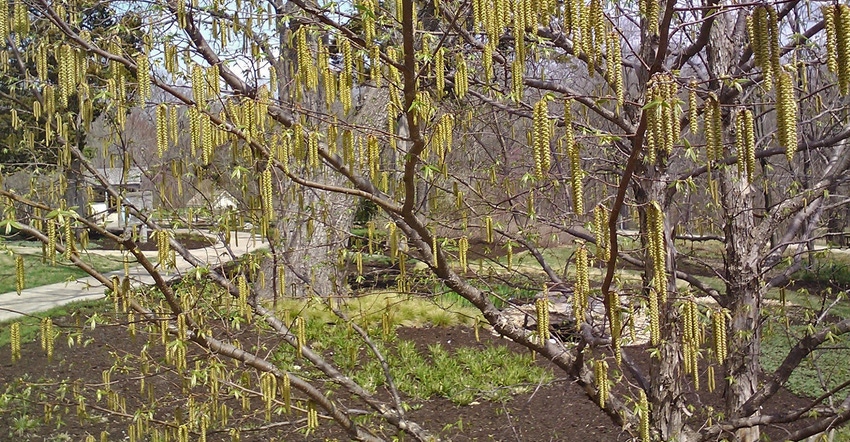April 12, 2019

One of life’s simple joys happens when winter finally yields to spring. Dormant woodlands of grey twigs, brown bark and tan leaf litter suddenly come to life.
Every year, silver maple, sugar maple and ash turn treetops purple, chartreuse and mauve with their flowers. They are the first noticeable colors painted across the forested Interstate 44 corridor in spring.
Less obvious, but no less beautiful, are the purple or yellow catkins — or male flowers — of hazelnut, black alder, river birch, hop hornbeam and musclewood, all remarkable woody plants in the birch family that work well in small gardens and attract myriad early pollinators on warm, sunny days.
Bearing fruit
Consider planting plums, short-lived as they are, because they flower nicely in spring and produce fruits that may be turned into tasty jam. Big tree plum produces the biggest wild plums, which are a whopping one and a half inches in diameter.
Pawpaw also is top on the list of early spring-flowering edibles because the blossoms are heavenly, particularly to pollinating flies. These are the first colorful brush strokes of spring, a warmup of what is still to come.

BURSTING BUCKEYES: Buckeyes are not just a college football team from Ohio. They are a prevalent tree in that state but can be grown in other regions as well.

Rocky terrain tolerant
If you are fortunate to live near a rocky glade in the Ozarks, you are lucky enough, because there is so much living diversity that exists on or near glades. At the glade edge, you might notice eastern red cedar draped in yellow flowers (technically male cones) or the puffs of yellow pollen that follow.
Keep in mind that cedar trees are not welcome on natural glades because they take over, and redbuds can be somewhat weedy in gardens. Be sure to pull unwanted seedlings early, or their roots will quickly grow.
When redbud is ending its bloom, flowering dogwood begins. Its four-corner blossoms hover in the woods by the thousands, like chimney smoke lingering on a calm, cold morning. Soon after, fringe tree blooms with fragrant, frilly cream-colored clusters of drooping petals. These plants tolerate extreme dry-rocky garden soils but also are easy to grow in most gardens with varying soil types.
Flowering trees
Buckeyes are found in the wild along rivers and creeks. Both red and Ohio buckeye, with their intoxicating colorful flowers, attract humans, tiger swallowtails and hummingbirds. They are great candidates for use in or around rain gardens because they tolerate flooding and drought.
Red buckeye is the most satisfying flowering tree of all to grow because it will bloom within two to three years from seed. In 10 years, it will grow to a stately rounded tree 8 feet tall and wide. By contrast, Ohio buckeye takes its sweet time, growing 10 feet in 20 years and exhibiting various growth forms.
Life is full of surprises and discoveries to be made, especially if you go outside, get lost and see for yourself.
Woodbury is the curator of the Whitmire Wildflower Garden at Shaw Nature Reserve in Gray Summit, Mo., where he has worked with native plant propagation, design and education for 27 years. He also is an adviser to the Missouri Prairie Foundation’s Grow Native! program.
About the Author(s)
You May Also Like




